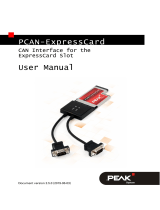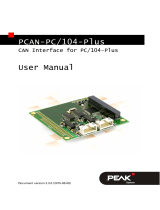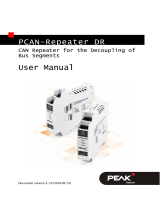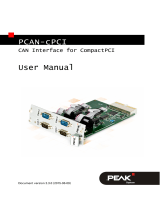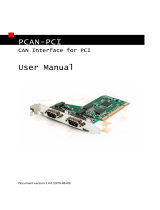Page is loading ...

CAN Interface for the
ExpressCard/34 Slot
User Manual
PCAN-ExpressCard
34
Document version 1.1.0 (2015-06-16)

PCAN-ExpressCard 34 – User Manual
2
Products taken into account
Product Name Model Part Number
PCAN-ExpressCard 34 One CAN channel IPEH-003004
CANopen® and CiA® are registered community trade marks of CAN in Automation
e.V.
All other product names mentioned in this document may be the trademarks or
registered trademarks of their respective companies. They are not explicitly marked
by “™” and “®”.
Copyright © 2015 PEAK-System Technik GmbH
Duplication (copying, printing, or other forms) and the electronic distribution of this
document is only allowed with explicit permission of PEAK-System Technik GmbH.
PEAK-System Technik GmbH reserves the right to change technical data without
prior announcement. The general business conditions and the regulations of the
license agreement apply. All rights are reserved.
PEAK-System Technik GmbH
Otto-Roehm-Strasse 69
64293 Darmstadt
Germany
Phone: +49 (0)6151 8173-20
Fax: +49 (0)6151 8173-29
www.peak-system.com
info@peak-system.com
Documen
t version 1.1.0 (2015-06-16)

PCAN-ExpressCard 34 – User Manual
3
Contents
1 Introduction 5
1.1 Properties at a Glance 5
1.2 Prerequisites for Operation 6
1.3 Scope of Supply 6
2 Installing the Software and the Card 7
3 Connecting the CAN Bus 8
3.1 D-Sub Connector 8
3.2 Cabling 8
3.2.1 Termination 8
3.2.2 Example of a Connection 9
3.2.3 Maximum Bus Length 9
4 Operation 10
4.1 Status LED 10
4.2 Removing the Adapter 10
5 Software and API 11
5.1 Monitor Software PCAN-View 11
5.1.1 Receive/Transmit Tab 14
5.1.2 Trace Tab 16
5.1.3 PCAN-ExpressCard 34 Tab 17
5.1.4 Status Bar 17
5.2 Linking Own Programs with PCAN-Basic 18
5.2.1 Features of PCAN-Basic 19
5.2.2 Principle Description of the API 20
5.2.3 Notes about the License 21
6 Technical Specifications 22

PCAN-ExpressCard 34 – User Manual
5
1 Introduction
The CAN adapter PCAN-ExpressCard 34 allows the connection of a
CAN bus to embedded PCs and laptops with ExpressCard slots. A
galvanic isolation of up to 300 Volts decouples the PC from the CAN
bus. Device drivers and programming interfaces exist for different
operating systems, so programs can easily access a connected CAN
bus.
Tip: At the end of this manual (Appendix C) you can find a
Quick Reference with brief information about the installation
and operation of the PCAN-ExpressCard 34.
1.1 Properties at a Glance
Card for ExpressCard slot
Type ExpressCard/34 (compatible with ExpressCard/54 slots)
1 High-speed CAN channel (ISO 11898-2)
Compliant with CAN specifications 2.0A (11-bit ID)
and 2.0B (29-bit ID)
Bit rates from 5 kbit/s up to 1 Mbit/s
CAN bus connection via D-Sub, 9-pin (in accordance to
CiA® 102)
FPGA implementation of the CAN controller
(SJA1000 compatible)
NXP PCA82C251 CAN transceiver
Galvanic isolation on the CAN connection up to 300 V
Extended operating temperature range from -40 to 85 °C
(-40 to 185 °F)

PCAN-ExpressCard 34 – User Manual
6
Note: This manual describes the use of the PCAN-ExpressCard
34 with Windows. You can find device drivers for Linux and the
corresponding application information on the provided DVD in
the directory branch Develop and on our website under
www.peak-system.com/linux.
1.2 Prerequisites for Operation
ExpressCard slot in the computer, type ExpressCard/34
Operating system Windows 8.1, 7, Vista (32/64-bit)
or Linux (32/64-bit)
1.3 Scope of Supply
PCAN-ExpressCard 34 CAN interface
Device drivers for Windows 8.1, 7, Vista and Linux (32/64-bit)
PCAN-View CAN monitor for Windows 8.1, 7, Vista (32/64-bit)
PCAN-Basic programming interface consisting of an interface
DLL, examples, and header files for all common programming
languages
Manual in PDF format

PCAN-ExpressCard 34 – User Manual
7
2 Installing the Software and
the Card
This chapter covers the software setup for the PCAN-ExpressCard
34 under Windows and the installation in the computer.
Setup the driver before
connecting the PCAN-ExpressCard 34 for
the first time.
Do the following to install the driver:
1. Insert the supplied DVD into the appropriate drive of the
computer. Usually a navigation program appears a few
moments later. If not, start the file Intro.exe from the root
directory of the DVD.
2. In the main menu, select Drivers, and then click on
Install now.
3. Confirm the message of the User Account Control regarding
the "Installer Database of PEAK Drivers".
The setup program for the driver is started.
4. Follow the instructions of the program.
Do the following to connect the PCAN-ExpressCard 34 to the
computer and complete the initialization:
1. Insert the PCAN-ExpressCard 34 into an ExpressCard slot of
your computer. The computer can remain powered on.
Windows notifies that new hardware has been detected. The
drivers are found and installed by Windows.
After the initialization process is finished successfully the red LED
on the PCAN-ExpressCard 34 is illuminated. Furthermore, you can
find the entry “PCAN-ExpressCard 34” in the branch “CAN-
Hardware” of the Windows Device Manager.

PCAN-ExpressCard 34 – User Manual
8
3 Connecting the CAN Bus
3.1 D-Sub Connector
A High-speed CAN bus (ISO 11898-2) is connected to the 9-pin D-
Sub connector. The pin assignment corresponds to the specification
CiA® 102.
Figure 1: Pin assignment High-speed CAN
3.2 Cabling
3.2.1 Termination
A High-speed CAN bus (ISO 11898-2) must be terminated on both
ends with 120 Ohms. Otherwise, there are interfering signal
reflections and the transceivers of the connected CAN nodes (CAN
interface, control device) will not work.
The PCAN-ExpressCard 34 does not have an internal termination.
Use the adapter on a terminated CAN bus.

PCAN-ExpressCard 34 – User Manual
9
3.2.2 Example of a Connection
Figure 2: Simple CAN connection
In this example, the PCAN-ExpressCard 34 is connected with a
control unit by a cable that is terminated at both ends.
3.2.3 Maximum Bus Length
High-Sp
eed-CAN networks may have bit rates of up to 1 Mbit/s. The
maximum bus length depends primarily on the bit rate.
The following table shows the maximum possible CAN bus length
at different bit rates:
Bit rate Bus length
1 Mbit/s 40 m
500 kbit/s 110 m
250 kbit/s 240 m
125 kbit/s 500 m
50 kbit/s 1.3 km
20 kbit/s 3.3 km
10 kbit/s 6.6 km
5 kbit/s 13.0 km
The listed values have been calculated on the basis of an idealized
system and can differ from reality.

PCAN-ExpressCard 34 – User Manual
10
4 Operation
4.1 Status LED
The PCAN-ExpressCard 34 has a status LED which may be in one of
the following conditions:
Status LED Meaning
On There's a connection to a driver of the operating system.
Slow blinking A software application is connected to the CAN channel.
Quick blinking Data is transmitted via the connected CAN bus.
4.2 Removing the Adapter
Under Windows the icon for removing hardware safely is not used
with the PCAN-ExpressCard 34. You may remove the card from the
computer without any preparation under Windows.

PCAN-ExpressCard 34 – User Manual
11
5 Software and API
This chapter covers the provided software PCAN-View and the
programming interface PCAN-Basic.
5.1 Monitor Software PCAN-View
PCAN-View is simple Windows software for viewing, transmitting,
and logging CAN- and CAN FD messages.
Note: This chapter describes the use of PCAN-View with a CAN
adapter.
Figure 3: PCAN-View for Windows

PCAN-ExpressCard 34 – User Manual
12
Do the following to start and initialize PCAN-View:
1. Open the Windows Start menu or the Windows Start page
and select the entry PCAN-View.
The dialog box for selecting the hardware and for setting
the parameters appears.
Figure 4: Selection of the specific hardware and parameters
2. From the list Available PCAN hardware, select the desired
interface to be used.
3. Select the bit rate that is used by all nodes on the CAN bus
from the drop-down list Bit rate. Use the button to the right
of the drop-down list to create User-defined bit rates.
4. Under Filter settings you can limit the range of CAN IDs to
be received, either for standard frames (11-bit IDs) or for
extended frames (29-bit IDs).

PCAN-ExpressCard 34 – User Manual
13
5. Activate the Listen-only mode if you do not actively
participate in the CAN traffic and just want to observe. This
also avoids an unintended disruption of an unknown CAN
environment (e.g. due to different bit rates).
6. Finally, confirm the settings in the dialog box with OK. The
main window of PCAN-View appears (see Figure 5).

PCAN-ExpressCard 34 – User Manual
14
5.1.1 Receive/Transmit Tab
Figure 5: Receive/Transmit tab
The Receive/Transmit tab is the main element of PCAN-View. It
contains two lists, one for received messages and one for the
transmit messages. Representation of CAN data is in hexadecimal
format.
Do the following to transmit a CAN message with PCAN-View:
1. Select the menu command Transmit > New Message
(alternatively or Ins).
The dialog box New Transmit Message is shown.

PCAN-ExpressCard 34 – User Manual
15
Figure 6: Dialog box new transmit message
2. Enter the ID and the data for the new CAN message.
3. The field Cycle Time indicates if the message shall be
transmitted manually or periodically. If you want to transmit
the message periodically, you must enter a value greater
than 0. For a manual-only transmission enter 0.
4. Confirm the entries with OK.
The created transmit message appears on the
Receive/Transmit tab.
5. You trigger selected transmit messages manually with the
menu command Transmit > Send (alternatively Space bar).
The manual transmission for CAN messages being
transmitted periodically is carried out additionally.
Tip: Using the menu command File > Save the current transmit
messages can be saved to a list and loaded for reuse later on.

PCAN-ExpressCard 34 – User Manual
16
5.1.2 Trace Tab
Figure 7: Trace tab
On the Trace tab the data tracer of PCAN-View is used for logging
the communication on a CAN bus. During this process the CAN
messages are cached in the working memory of the PC. Afterwards
they can be saved to a file.
The tracer can be configured to run in linear or in ring buffer mode.
In linear buffer mode the logging is stopped as soon as the buffer is
filled completely. In ring buffer mode the oldest messages are
overwritten by incoming ones.

PCAN-ExpressCard 34 – User Manual
17
5.1.3 PCAN-ExpressCard 34 Tab
Figure 8: PCAN-PCI tab (example)
On the PCAN-ExpressCard 34 tab various information about your
hardware is displayed, like the current device driver version.
5.1.4 Status Bar
Figure 9: Example of the status bar
The status bar shows information about the current CAN
connection, about error counters (Overruns, QXmtFull), and shows
error messages.
You can find further information about the use of PCAN-View in the
help which you can invoke in the program via the Help menu or
with the F1 key.

PCAN-ExpressCard 34 – User Manual
18
5.2 Linking Own Programs with PCAN-Basic
Figure 10: PCAN-Basic
On the provided DVD you can find files of the programming
interface PCAN-Basic in the directory branch Develop. This API
provides basic functions for linking own programs to CAN- and CAN
FD interfaces by PEAK-System and can be used for the following
operating systems:
Windows 8.1, 7, Vista (32/64-bit)
Windows CE 6.x (x86/ARMv4)
Linux (32/64-bit)
The API is designed for cross-platform use. Therefore software
projects can easily ported between platforms with low efforts. For
all common programming languages examples are available.
Beginning with version 4, PCAN-Basic supports the new CAN FD
standard (CAN with Flexible Data Rate) which is primarily
characterized by higher bandwidth for data transfer.

PCAN-ExpressCard 34 – User Manual
19
5.2.1 Features of PCAN-Basic
API for developing applications with CAN and CAN FD
connection
Access to the CAN channels of a PCAN-Gateway via the new
PCAN-LAN device type
Supports the operating systems Windows 8.1, 7, Vista
(32/64-bit), Windows CE 6.x, and Linux (32/64-bit)
Multiple PEAK-System applications and your own can be
operated on a physical channel at the same time
Use of a single DLL for all supported hardware types
Use of up to 16 channels for each hardware unit (depending on
the PEAK CAN interface used)
Simple switching between channels of a PEAK CAN interface
Driver-internal buffer for 32,768 messages per CAN channel
Precision of time stamps on received messages up to 1 μs
(depending on the PEAK CAN interface used)
Supports PEAK-System‘s trace formats version 1.1 and 2.0 (for
CAN FD applications)
Access to specific hardware parameters, such as listen-only
mode
Notification of the application through Windows events when a
message is received
Extended system for debugging operations
Multilingual debugging output
Output language depends on operating system
Debugging information can be defined individually

PCAN-ExpressCard 34 – User Manual
20
An overview of the API functions is located in the header files. You
can find detailed information about the PCAN-Basic API on the
provided DVD in the text and help files (file name extensions .txt
and .chm).
5.2.2 Principle Description of the API
The PCAN
-Basic API is the interface between the user application
and device driver. In Windows operating systems this is a DLL
(Dynamic Link Library).
The sequence of accessing the CAN interface is divided into three
phases:
1. Initialization
2. Interaction
3. Completion
Initialization
A channel must be initialized before using it. This is done by the
simple call of the function
CAN_Initialize for CAN and
CAN_InitializeFD for CAN-FD. Depending on the type of the CAN
hardware, up to 16 CAN channels can be opened at the same time.
After a successful initialization the CAN channel is ready for
communication with the CAN hardware and the CAN bus. No
further configuration steps are required.
Interaction
For receiving and transmitting messages the functions
CAN_Read and
CAN_Write as well as CAN_ReadFD and CAN_WriteFD are available.
Additional settings can be made, e.g. setting up message filters to
confine to specific CAN IDs or setting the CAN controller to listen-
only mode.
/

